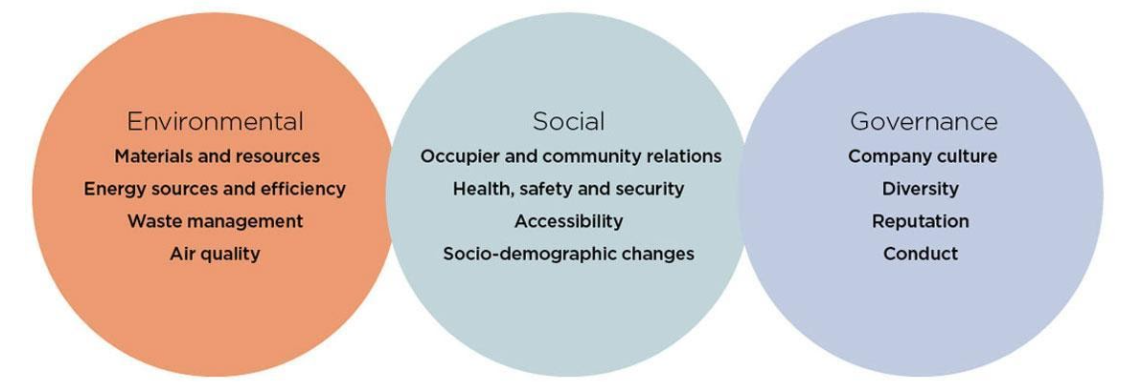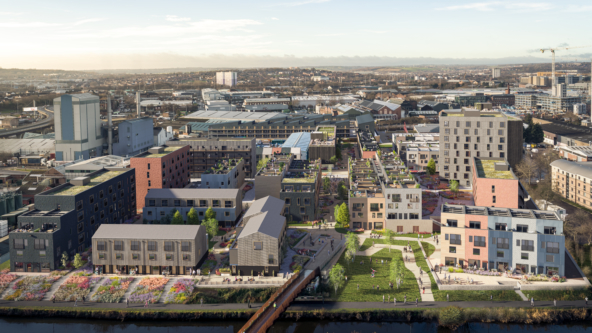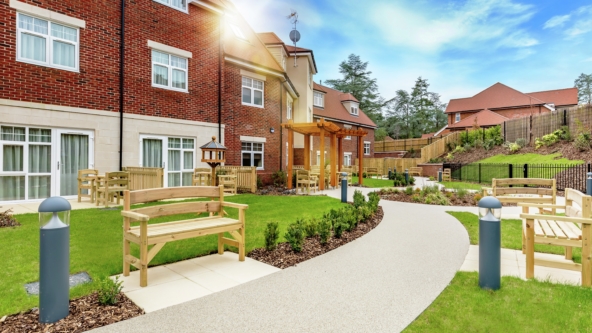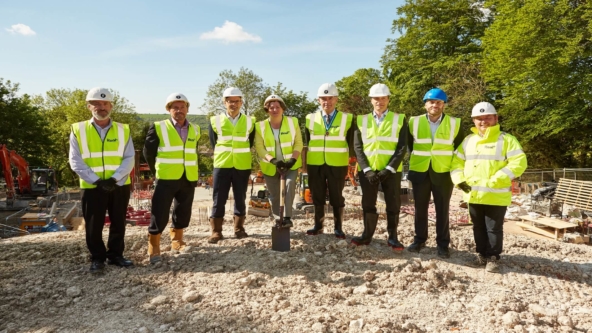Impact investing and ESG in real estate
Investor demand is rising for assets managed with environmental, social and governance considerations, making the case for having a robust ESG strategy far stronger. Backed up by data from JP Morgan, ESG-related investing through 2020 is pushing $45 trillion, and a recent report by the European Fund and Asset Management Association (EFAMA) finds almost half of all European assets under management were invested with some form of ESG (Environmental Social Governance) selection.
These figures continue to grow, and as a business with our own commitments to deliver positive social impact, Octopus Real Estate seeks not just to align with industry targets, but to challenge ourselves go much further. This means embracing all that ESG has to offer.
We met with Simon Rainsford and Sam Wallis of Envision to talk more about ESG, its relevance in real estate for impact investment and how a best practice approach can help build a compliant, climate centric and future proof strategy.
Defining ESG
The whole point of ESG in the context of investment is to help create assets that have environmental or social impact, using rigorous processes, that exist alongside (not replace) a financial return. For real estate this includes improving the environmental profile of a building, from build through to tenancy, as well as looking at the value that the real estate brings to the location in which it’s built.
Our partnership with Envision has taught us much about ESG and the valuable lessons learned have fed into our business-wide review of our impact strategy.
Key to achieving a successful ESG strategy is to deliver against investor expectation. There’s a greater need for transparency and disclosure around the principles and mechanics of an investment and ensuring ESG practice is maintained is the way to achieve impact.

Why now? Climate change and regulatory targets
The need for rapid decarbonisation of the built environment is clear. UN backed initiative GlobalABC demonstrate in their 2020 annual report of the building sector, how the industry is now responsible for 38% of all global emissions. Pitch this alongside a +1.5 degree climate change target set by the Paris Agreement, and the UK’s commitment for Net Zero by 2050, that’s a 78% reduction in carbon over 15 years.
This ambitious target requires collective action, solved only by private, governmental, policy and community stakeholders all working together to create a trajectory that tracks ahead of national policy. Failure to do so not only confronts the viability of an investment, but importantly also reputation. With assets at risk of missing decarbonisation targets and then also regulatory requirements, we must act now.
Fortunately, the industry is starting to change and the questions being asked now include whether they will find a buyer in 20 years’ time who is willing to take on an investment exposed to climate-related risk.
ESG applies to both new and existing investments
ESG can apply throughout the investment process, from due diligence to ongoing management and occupancy. It’s crucial to collect key data to report back to the real world, to not only demonstrate performance against impact, but also to validate the ESG strategy.
Whilst ESG can be baked in to the materials, design and infrastructure when looking at a new development, existing assets require a different approach. This begins with an energy and sustainability asset review to benchmark the portfolio and understand areas of risk and opportunity.
For this, we can leverage BREEAM In Use Certification. Simon explains, “We never understand the full value of an asset without data. Reading the impact of energy use helps set out guidelines for best practice. Using tools like BREEAM to map the environmental profile of a building, and by ascertaining portfolio level risk we can overlay data to identify gaps at an asset level, and this helps build targets and actions.”
In fact realistic targets are a vital component of ESG management and by understanding how to better improve existing assets and what strategies work we can inform other business lines to help them pursue their own Net Zero goals.
For Octopus Real Estate we are aiming to achieve EPC ‘B’ or better for 97.5% of our care home portfolio within 3 years, and 25% ‘A’ or better. We’re proud to already be tracking well ahead of industry average with 20% EPC ‘A’.
Putting ESG into Practice
To help plan any decarbonisation measures you must perform the right assessment and Envision make use of tools such as ‘Digital Twinning’, whereby a computer model of the physical asset is created (the digital twin), which combines real life energy consumption data to form a rational viewpoint of the asset. This in turn informs us of its viability for ESG and determines measures for action. It’s then possible, through data, to stay on track for all measurable targets.
A real world example of ESG implementation is seen with Ashbourne Court Care Home; the digital twin shows an existing EPC grade B, equivalent to 138 tonnes of CO2 per year. Largely attributed to hot water use, gas consumption is understandably high meaning Net Zero is some way off, and so we must first work to improve the EPC from grade B to A. However improving an existing and occupied asset requires minimal disruption and that means tenant engagement.
Sam explains how this can be achieved in three steps with Ashbourne Court :
- Phased replacement of all lighting to low energy LED
- Insulation of tanks and pipework for improved hot water efficiency.
- Installation of solar panels for energy supply
These measures will save 30 tonnes of CO2 per year, but the carbon footprint remains high due to high hot water gas consumption. Net Zero is more ambitious and requires additional steps, notably the elimination of any usage of fossil fuels and this means converting all heating and hot water systems from gas to a more expensive all electric system.
What we do know is that an all-electric building will be futureproofed for decarbonisation. The National Grid Future Energy Scenarios strategy shows an increasing amount of electricity being generated from renewable sources, and so the carbon impact of moving to efficient electrical based solutions will eventually disappear.
For the purpose of achieving Net Zero, by upgrading Ashbourne Court to a fully electric building, the footprint drops from 108 to only 43 tonnes per year and the real world carbon footprint is more than halved.
Stranding Risk and OpEx
Stranding is the point at which an asset becomes exposed to an increased risk of economical obsolescence – be this be due to market conditions or regulatory changes. To avoid stranding we must reduce our carbon footprint prior to the forecasted stranding date.
Explaining how to calculate stranding, Sam describes the use of the CRREM model (Carbon Risk Real Estate Monitor) and under current criteria we can see that 2031 is when Ashbourne Court could become exposed. Steps to decarbonise must therefore happen pre-2031. The data from Digital Twinning shows that measures to achieve an EPC ‘A’ grade must be targeted now, and Net Zero measures can be implemented between now and 2030. In doing so we can keep to our carbon trajectory, reduce our exposure to stranding whilst also remaining compliant for all targets, impact and investor expectations.
What is the financial impact of such significant upgrades? Again using our example of Ashbourne Court we can begin to map this out in real terms.
The first step for EPC ‘A’ is estimated to cost £120,000 and reduces our utility spend by a third with an equivalent 8.4 years to payback.
The additional step for Net Zero will cost in the order of £180,000 however unlike with EPC ‘A’ measures this spend does not translate into OpEx savings as despite the major upgrade converting a building to fully electric, where electricity is 3-4 times more efficient than gas, it’s also 3-4 times more expensive. Consequently, with only a £7,000 annual reduction in utility spend from this upgrade, and an equivalent 27 years of payback, the benefits will take much longer to realise based on current energy market conditions.
Sam asserts, “Clearly this exercise is not an OpEx saving measure but led by regulations, market demands and linked back to the cost of an asset stranding.”
Act now
Concluding the session Sam Wallis discusses perspective, and carbon negativity. “From an investment standpoint, retirement real estate is a mid term hold and implementation of ESG can futureproof any sale potential. As it’s hard to decarbonise high hot water usage, you may never achieve carbon negative for a leisure facility or student accommodation. In a sector like retail where little to no hot water is consumed, Net Zero measures can be far more effective and can help balance carbon output for a portfolio.”
So the trick is in realising that ESG issues will become increasingly urgent and that we can’t wait and act in 10 years as it will simply be too late. Based on the current regulatory landscape and utility costs, the next decade will see even more change so the goal posts could also keep moving. It therefore makes every sense to start now, and with the benefit of learnings from partners such as Envision we can apply ESG criteria across the rest of Octopus Real Estate and beyond.
If you are interested in working with us we would love to hear from you. Please do contact us to arrange a time for further discussion.







